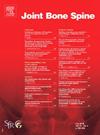一项大规模的多组学多基因风险评分分析确定了与类风湿关节炎相关的候选风险位点。
IF 3.8
3区 医学
Q1 RHEUMATOLOGY
引用次数: 0
摘要
目的:本研究旨在探讨多组学多基因风险评分(PRS)与类风湿关节炎(RA)的相关性,以发现潜在的基因/蛋白和生物学途径。方法:基于来自INTERVAL队列中48813名参与者的多组学数据,我们计算了13646种mrna (RNASeq)、308种蛋白质(Olink)、2380种蛋白质(SomaScan)、726种代谢物(Metabolon)和141种代谢物(Nightingale)的多组学PRS。使用广义线性模型,我们首先评估了58,813名英国生物银行参与者的多组学PRS和RA之间的关系。通过基因本体(GO)计划和京都基因与基因组百科全书(KEGG)来确定RA的功能途径。此外,差异基因表达谱数据集用于验证我们研究中鉴定的基因/蛋白。结果:我们鉴定出59个转录组PRS和29个蛋白质组PRS与RA显著相关。蛋白质组学和转录组学均鉴定出HLA-DQA2 (RNASeq: OR=1.19, P=1.18×10-24;SomaScan: OR=1.24, P=4.43×10-27)和AGER (RNASeq: OR=0.91, P=4.18×10-4;SomaScan: OR=0.93, P=3.97×10-3)与RA显著相关。来自不同分析平台(SomaScan和Olink)的蛋白质组学PRS确定了TFF3之间的一致关联(SomaScan: OR=0.90, P=4.08×10-6;相关性:OR=0.93, P=4.87×10-3)和RA。所鉴定的基因/蛋白主要富集于NF-kappa B信号通路(hsa04064, P=5.06×10-5)和细胞因子-细胞因子受体相互作用(hsa04060, P=2.49×10-4)。此外,我们的研究中共有12个候选基因在两个独立的GEO数据集中进行了验证,如FLOT1和ABCF1。结论:我们的研究结果从多组学水平对已鉴定的基因/蛋白和途径参与RA的发病机制提供了新的见解。本文章由计算机程序翻译,如有差异,请以英文原文为准。
A large-scale multi-omics polygenic risk score analysis identified candidate risk locus associated with rheumatoid arthritis
Objective
This study aimed to investigate the associations of multi-omics polygenic risk score (PRS) and rheumatoid arthritis (RA) to identify potential genes/proteins and biological pathways.
Methods
Based on multi-omics data from 48,813 participants in the INTERVAL cohort, we calculated multi-omics PRS for 13,646 mRNAs (RNASeq), 308 proteins (Olink), 2380 proteins (SomaScan), 726 metabolites (Metabolon), and 141 metabolites (Nightingale). Using the generalized linear model, we first evaluated the associations between multi-omics PRS and RA in 58,813 UK Biobank participants. The Gene Ontology (GO) project and Kyoto Encyclopedia of Genes and Genomes (KEGG) were performed to identify the functional pathways in RA. Furthermore, differential gene expression profile datasets were used to validate the identified genes/proteins in our study.
Results
We identified 59 transcriptomics PRS and 29 proteomics PRS significantly associated with RA. Both proteomics and transcriptomic PRS identified HLA-DQA2 (RNASeq: OR = 1.19, P = 1.18 × 10–24; SomaScan: OR = 1.24, P = 4.43 × 10–27) and AGER (RNASeq: OR = 0.91, P = 4.18 × 10–4; SomaScan: OR = 0.93, P = 3.97 × 10–3) were significantly associated with RA. Proteomic PRS from different profiling platforms (SomaScan and Olink) identified a consistent association between TFF3 (SomaScan: OR = 0.90, P = 4.08 × 10–6; Olink: OR = 0.93, P = 4.87 × 10–3) and RA. The identified gene/proteins were mainly enriched in the NF-kappa B signaling pathway (hsa04064, P = 5.06 × 10–5) and Cytokine-cytokine receptor interaction (hsa04060, P = 2.49 × 10–4). In addition, a total of 12 candidate genes in our study were verified in two independent GEO datasets, such as FLOT1 and ABCF1.
Conclusion
Our findings provide novel insights into the involvement of identified genes/proteins and pathways in the pathogenesis of RA from multi-omics levels.
求助全文
通过发布文献求助,成功后即可免费获取论文全文。
去求助
来源期刊

Joint Bone Spine
医学-风湿病学
CiteScore
4.50
自引率
11.90%
发文量
184
审稿时长
25 days
期刊介绍:
Bimonthly e-only international journal, Joint Bone Spine publishes in English original research articles and all the latest advances that deal with disorders affecting the joints, bones, and spine and, more generally, the entire field of rheumatology.
All submitted manuscripts to the journal are subjected to rigorous peer review by international experts: under no circumstances does the journal guarantee publication before the editorial board makes its final decision. (Surgical techniques and work focusing specifically on orthopedic surgery are not within the scope of the journal.)Joint Bone Spine is indexed in the main international databases and is accessible worldwide through the ScienceDirect and ClinicalKey platforms.
 求助内容:
求助内容: 应助结果提醒方式:
应助结果提醒方式:


